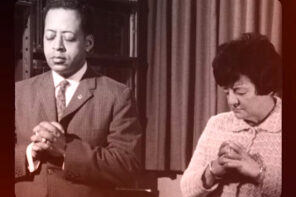Author’s note: What follows was submitted to Religion Dispatches some months before the Occupy Wall Street movement began. Thus there is no reference to that movement in the essay, only a vague hope for what I had yet to see.
* * *
Who’s That Lady?
Mary Magdalene is justly celebrated as a feminist icon, for like womankind in general she has been the object of endless projection, one fantasy after another luridly tattooed on the screen of her flesh. That some of these projections are in fact feminist projections only confirms her status as a saint for our times. Mary of Magdala is Mary of Irony, too.
Like the Son of man who “bears the sins of the world,” this Daughter of woman bears that most pernicious form of sin: the need to remake another human being according to the image, the label, the notion that best suits our agendas at any given time.
Behold my soul mate, my polar opposite, my better half, my ball and chain, my dissertation topic, my role model, my muse, my T & A, the girl of my dreams—anything but the Divine Image embodied in a unique and to a large degree unknowable human being.
Do you recall when the National Endowment for the Arts came under fire for supporting an artist who’d submerged a crucifix in a container of urine? It was called the “Piss Christ.” Behold the Piss Mary: repentant whore, ascetic wretch, messianic squeeze, grand dame of the heterodox—anointed and reeking in every generation.
I wish that José Clemente Orozco, who painted Christ chopping down his own cross, were alive to paint Mary. I imagine her painted with an outward-turned mirror in front of her face, which to her followers would mean, “You are no less holy than I”; and to her fans, “Keep your projections to yourself.”
Of Magdala
If the Mary of the Gnostic gospel that bears her name is largely its author’s invention, the Mary we meet in the canonical gospels is probably a radical abridgement, a smudged, largely erased portrait of the Teacher’s best friend. What remains, however, is so altogether provocative that we ought to be grateful not to have more, much as we would like to have more. Like the terrifying voice of God on Sinai, more might be more than we could stand.
The first thing we “know” about Mary Magdalene is the detail that has become part of her name, that she is identified with a particular place. Mary comes from somewhere. She carries that somewhere around with her the way we carry our names—often it is her name: The Magdalene.
Merely to say it aloud sounds like a thunderous indictment of a culture in which people increasingly live nowhere; in which upright featherless bipeds believe it is their God-given right to fly; in which our movers and shakers rarely stay in one place long enough to evaluate, much less to clean up, the messes they make; in which we “love the earth” as an abstract blue ball photographed from a space capsule and adored as desktop wallpaper; in which even our so-called tree huggers rarely stick around long enough to hug the same tree.
For an age of perpetual displacement, Mary stands as a person “in place.” Yes, the Son of man has no place to lay his head, but that is not the same as having no place to ground one’s thoughts. It is not the same as having one’s head in the micro-soft clouds. If the Nazarene is to have a consort, who else but the Magdalene, who never shakes the dust of home from her name?
Out of Whom Went Seven Devils
If Mary Magdalene were on earth today, and if Jesus had effected some cure comparable to an exorcism in her life . . . if Mary Magdalene were on earth today, and if anybody had effected any kind of a cure in her life, the cure would not be so complete as to have freed her from being identified by her disease. She would be tagged as a “devil survivor,” a “recovering demoniac,” a poster child for some elite guild of exorcists, a logo on their amulets.
As in: “Dear Ms. Magdalene, As a breast cancer survivor, you surely understand the importance of being reminded of your brush with death every time you pick up a head of lettuce from the pink beribboned produce aisle at the supermarket. For that reason you will certainly want to . . .”
A society based on marketing creates a humanity based on identifiers: we are labeled just as our products are, the better to make lucrative “matches” between them. I get a kick out of the phrase “racial profiling” even as I hate the thing it denotes; I get a kick out of its disingenuous modesty, as if we were about anything besides profiling. The inner city billboard with a suave black man sipping his Seagram’s 7—racial profiling, no?
When the resurrected Christ meets Mary Magdalene in the Garden, he does not call her by the name of her past affliction, not even by the name of her town. He calls her Mary. The scene reminds me of an episode of The Simpsons in which Homer says to a gay man: “Queer, that’s what you like to be called, right?” The man replies, “Either that or John.”
He calls her Mary. I assume that is how he knows her, and I assume that is how she wishes to be known. No wonder we can’t resist believing they are in love.
Who Ministered to Him of Their Substance
That’s Luke in the King James Bible. Traditionalists will want to put a domestic spin on “ministered”: Mary of Magdala and her female companions in Martha of Bethany’s aprons, bustling among the Twelve, asking Bartholomew if he’d like another dumpling. Commentators of a different stripe will latch onto the “follow” in Mark’s version—“who . . . followed him, and ministered unto him”—hoping to discern a higher-status ministry. Bishop trumps deacon trumps waitress trumps mom. Of course, these are the very same commentators who can’t say the word hierarchy without heaving their lunch.
But such is the essence of bourgeois exegesis, the signature crop circle imprint of that UFO fantasy popularly known as “culture war.” In other words: let us talk about anything but the substance, the resources, the capital, the way the good things of life—health care, education, arts, purple mountain majesties, exemption from battlefield maiming and slaughter—get divvied up.
You be the Red States and I’ll be the Blue, you be the conservative and I’ll be the progressive, you be the stodgy apologist for Euro-centric values and I’ll be the transgressive cultural studies maven and somehow we’ve gotten locked in the library alone together and we hate each other’s guts, but, like, in a horny sort of way—on and on and on while the children go without food because it’s the weekend and there’s no school lunch till Monday.
A plague on both your houses.
Mary puts her money where her mouth is. Woman of substance, she ministers with her substance. Call it what you will, it comes down to money. Verily, verily, I say unto you: the ecclesial meaning of Mary Magdalene is so much piss until you grasp and embrace the economic meaning of Mary.
The One Who Showed Up
Woody Allen is supposed to have said that 80 percent of success is showing up. That she showed up was 80 percent of what we can say about Mary Magdalene. She was there—at the cross and at the tomb—which also means she was there at the absolute point of “no fun,” no gain, perhaps even of no faith. If she didn’t believe that Jesus were truly dead, why did she bring spices?
If anything makes Mary Magdalene worthy of veneration in our time, it is the simple fact of her showing up. When the Son of man is dead, defeated, and seemingly debunked, she will not desert him. If God is dead, Mary will see to the corpse. When The God Delusion tops the best seller list, she’s the one dusting off the Torah scrolls in the discount bin.
If there is a path beyond belief and beyond atheism—which, after all, is but another form of belief, and lately a rather fundamentalist form to boot—Mary Magdalene walks that path. I have met others walking it with her, carrying their disillusionment like a cross. And still they show up, in pews, polling places, and picket lines, if only to bear witness to the certainty they once felt there.
In what may be the earliest depiction of Mary Magdalene, a third century wall painting taken from a house church in Dura-Europos and now on display at Yale, Mary approaches the Easter tomb crowned by a then-popular Roman hair style and carrying a torch. Bearer of our Projections, she resembles another woman who still carries the torch, holding it aloft over New York harbor. If democracy is dead, if plutocracy and imperial hubris have won out as thoroughly as the evidence suggests, what faith is left to us but hers? Mary Magdalene, lover till the end, pray for us.
Seed Beneath the Snow
The late Michael Harrington, a disciple of the quintessentially Magdalenian Dorothy Day, and an ex-Catholic who wore his loss of religious faith in the best Magdalenian style, wrote in the early 1970s:
It was as a socialist, and because I was a socialist, that I fell in love with America. In saying that I am not indulging in romantic nostalgia about youthful days on the road but rather underlining a crucial political truth. If the Left wants to change this country because it hates it, then the people will never listen to the Left and the people will be right. To be a socialist—to be a Marxist—is to make an act of faith, of love even, toward this land. It is to sense the seed beneath the snow; to see, beneath the veneer of corruption and meanness and the commercialization of human relationships, men and women capable of controlling their own destinies.
I am not claiming Mary Magdalene as a socialist or as a symbol of democracy triumphant. I am not claiming that she was able to perceive “the seed beneath the snow” of her beloved’s cold brow. I am claiming that she incarnates the only kind of activism that can see us through to resurrection, and its name is fearless and abiding love.
* * *
I wish to acknowledge three books that influenced this essay: Susan Haskins’s excellent study Mary Magdalene: Myth and Metaphor (New York: Riverhead Books, 1993), Christopher Beha’s The Whole Five Feet (New York: Grove, 2009), which in addition to being an affecting memoir of a man’s devotion to books also moved me with its depiction of lost faith, and finally Michael Harrington’s Fragments of the Century: A Social Autobiography (New York: Dutton, 1973).




